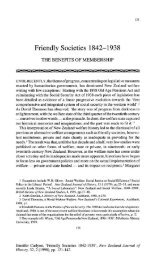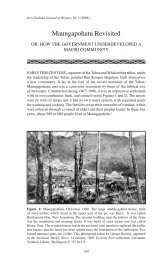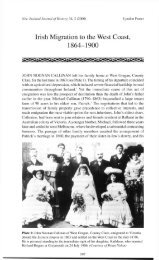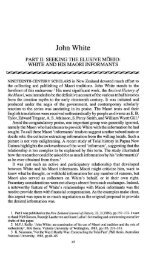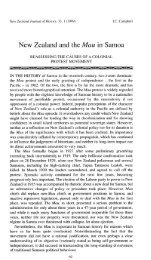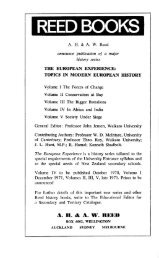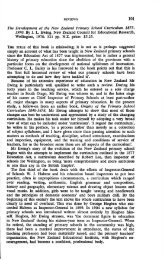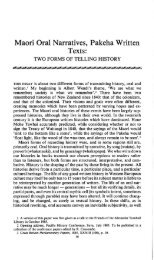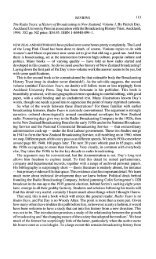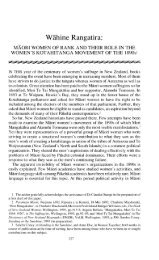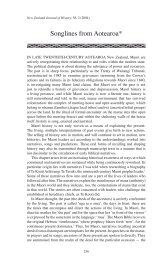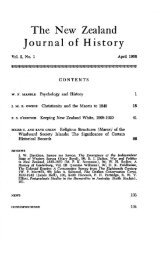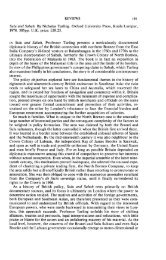Bishop G. A. Selwyn and the Melanesian Mission - New Zealand ...
Bishop G. A. Selwyn and the Melanesian Mission - New Zealand ...
Bishop G. A. Selwyn and the Melanesian Mission - New Zealand ...
You also want an ePaper? Increase the reach of your titles
YUMPU automatically turns print PDFs into web optimized ePapers that Google loves.
BISHOP G. A. SELWYN AND THE MELANESIAN MISSION 127<br />
worth more than three Frenchmen." ' 26 The problem was to find even<br />
one Englishman to combat ra<strong>the</strong>r more than three French priests.<br />
When <strong>Selwyn</strong> left <strong>New</strong> Zeal<strong>and</strong> in December 1853 on his famous<br />
visit to Engl<strong>and</strong>, one of his intentions was to select 'a few co-adjutors'<br />
for his <strong>Melanesian</strong> work who would remove <strong>the</strong> need for his constant<br />
oversight <strong>and</strong> also withst<strong>and</strong> <strong>the</strong> Roman threat. 27<br />
In this quest he was partially successful. When he returned to <strong>New</strong><br />
Zeal<strong>and</strong> in September 1855 he was accompanied by a missionary<br />
chaplain, <strong>the</strong> Reverend John Coleridge Patteson, a scholarly young<br />
priest with influential connections who had been combining an Oxford<br />
fellowship with a village curacy near his family's home in Devon. 28<br />
<strong>Selwyn</strong>'s formidable personal qualities — <strong>the</strong> imperious will <strong>and</strong> <strong>the</strong><br />
high prerogatives which he attached to his office as bishop — made<br />
him a difficult partner in any enterprise. Patteson was one of <strong>the</strong> few<br />
men who could work harmoniously with him in a position resembling<br />
equality, though even he had no illusions. Soon after his arrival in<br />
<strong>New</strong> Zeal<strong>and</strong> he wrote of <strong>Selwyn</strong>: 'he believes that a strict discipline<br />
must be carried out with a high h<strong>and</strong>: but it is I see doing harm with<br />
our crew. The officers will not st<strong>and</strong> his imperious way with <strong>the</strong>m<br />
.... <strong>the</strong>re is little to make <strong>the</strong>m love him in his dealings with <strong>the</strong>m,<br />
though a man of real honesty <strong>and</strong> integrity would acknowledge him<br />
as perfectly just.' 29 For his part <strong>Selwyn</strong> trusted his young assistant<br />
unreservedly as possessing '<strong>the</strong> very character which is needed in<br />
<strong>the</strong>se wild <strong>and</strong> trackless fields'. 30 Although he sailed to <strong>the</strong> isl<strong>and</strong>s<br />
each year from 1856 to 1859 on <strong>the</strong> principal exploratory voyage of<br />
<strong>the</strong> new mission schooner Sou<strong>the</strong>rn Cross, he soon committed to<br />
Patteson entire responsibility for <strong>the</strong> internal organization of <strong>the</strong><br />
mission <strong>and</strong> <strong>the</strong> annual return of scholars to <strong>the</strong>ir homes. From 1856,<br />
<strong>the</strong>refore, <strong>Selwyn</strong>'s connection with <strong>the</strong> <strong>Melanesian</strong> <strong>Mission</strong> was<br />
largely supervisory, <strong>and</strong> <strong>the</strong> shape it assumed after this date was due<br />
mainly to <strong>the</strong> personality <strong>and</strong> accumulated practical experience of<br />
Patteson himself.<br />
26 Lewis M. Hogg, A Letter to His Grace <strong>the</strong> Duke of <strong>New</strong>castle, Secretary<br />
of State for <strong>the</strong> Colonies ... on behalf of <strong>the</strong> <strong>Melanesian</strong> <strong>Mission</strong> of <strong>the</strong> <strong>Bishop</strong><br />
of <strong>New</strong> Zeal<strong>and</strong>, London, 1853, p. 8. Similar views were expressed by C. J.<br />
Abraham, headmaster of St. John's College, Extracts from <strong>New</strong> Zeal<strong>and</strong> Letters<br />
during <strong>the</strong> year 1851-2, pp. 31-32.<br />
27 Letter from <strong>Bishop</strong> <strong>Selwyn</strong>, S. Bamabas Day 1853 (privately circulated),<br />
p. 8.<br />
28 J. C. Patteson (1827-1871) educated at Eton <strong>and</strong> Balliol, elected to a<br />
fellowship at Merton in 1852, ordained deacon in 1853, priest in 1854. At <strong>the</strong><br />
time of <strong>Selwyn</strong>'s visit he was acting as curate of Alphington in <strong>the</strong> diocese of<br />
Exeter. His fa<strong>the</strong>r, Sir John Patteson, a retired High Court judge, was an old<br />
friend of <strong>Selwyn</strong>'s.<br />
29 J. C. Patteson to his fa<strong>the</strong>r, undated fragment [January 1856], Patteson<br />
Papers, Society for <strong>the</strong> Propagation of <strong>the</strong> Gospel Archives, Westminster (microfilm,<br />
Department of Pacific History, Australian National University).<br />
30 <strong>Selwyn</strong> to E. Coleridge, 14 July 1855, 'Letters from <strong>the</strong> <strong>Bishop</strong> of <strong>New</strong><br />
Zeal<strong>and</strong> <strong>and</strong> O<strong>the</strong>rs', I, 287.



